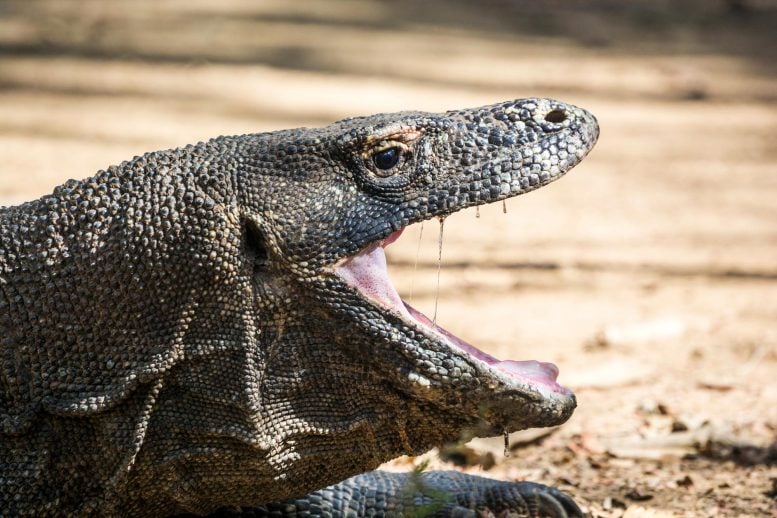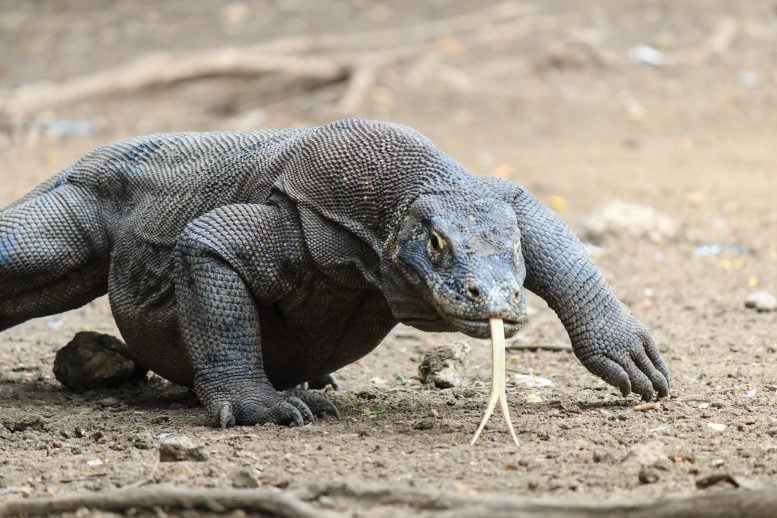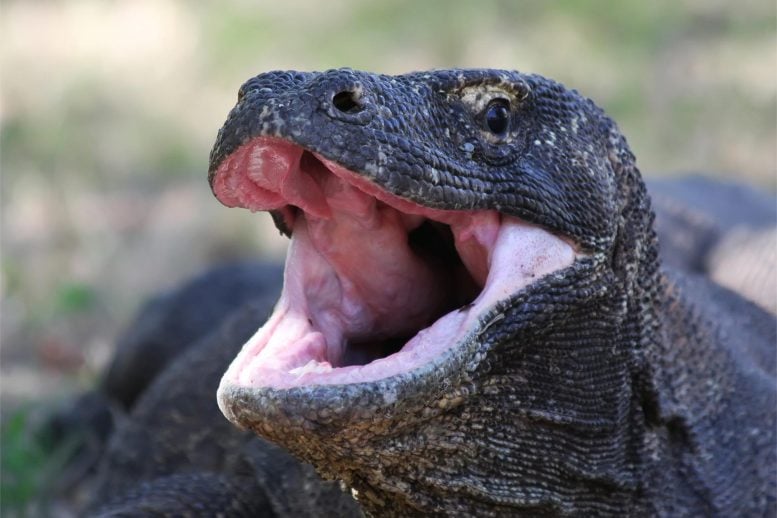
Scientists from King’s College London discovered that Komodo dragons’ serrated teeth are enhanced with iron, particularly concentrated along the cutting edges.
This feature, staining the teeth orange, helps keep them exceptionally sharp. The study analyzed teeth from Komodo dragons and explored potential similarities with dinosaur feeding behaviors, suggesting that this characteristic may provide insights into how dinosaurs like Tyrannosaurus rex might have used their teeth.
Komodo Dragons and Their Iron-Infused Teeth
Scientists have discovered that the serrated edges of Komodo dragons’ teeth are tipped with iron.
Led by researchers from King’s College London, the study gives new insight into how Komodo dragons keep their teeth razor-sharp and may provide clues to how dinosaurs like Tyrannosaurus rex killed and ate their prey.
Native to Indonesia, Komodo dragons are the largest living species of monitor lizard, averaging around 80kg. Deadly predators, Komodos have sharp, curved teeth similar to many carnivorous dinosaurs. They eat almost any kind of meat, from smaller reptiles and birds to deer, horses, or water buffalo, pulling and tearing at their prey to rip flesh apart.

The Role of Iron in Komodo Dragon Tooth Durability
The researchers discovered that many reptiles have some iron in their teeth, but Komodo dragons have concentrated the iron along the cutting edges and tips of their teeth, staining them orange. Crocodiles and other monitor lizards, by comparison, have so little that the iron is often invisible.
To understand the chemical and structural make-up of Komodo dragon’s teeth, scientists scoured museums for skulls and teeth of Komodo dragons and studied the teeth of Ganas, the 15-year-old Komodo dragon who had lived at ZSL conservation zoo, London Zoo.
Through advanced imaging and chemical analysis, the team was able to observe that the iron in Komodo dragons’ enamel is concentrated into a thin coating on top of their tooth serrations and tips. This protective layer keeps the serrated edges of their teeth sharp and ready to be used at a moment’s notice.
The research, published on July 24 in Nature Ecology & Evolution, leads to new questions and avenues for research into how extinct species such as dinosaurs lived and ate.

Comparing Komodo Dragon and Dinosaur Teeth
Dr. Aaron LeBlanc, lecturer in Dental Biosciences at King’s College London and the study’s lead author said: “Komodo dragons have curved, serrated teeth to rip and tear their prey just like those of meat-eating dinosaurs. We want to use this similarity to learn more about how carnivorous dinosaurs might have eaten and if they used iron in their teeth the same way as the Komodo dragon.
“Unfortunately, using the technology we have at the moment, we can’t see whether fossilized dinosaur teeth had high levels of iron or not. We think that the chemical changes that take place during the fossilization process obscure how much iron was present to start with.
“What we did find, though, was that larger meat-eating dinosaurs, like tyrannosaurs, did change the structure of the enamel itself on the cutting edges of their teeth. So, while Komodo dragons have altered the chemistry of their teeth, some dinosaurs altered the structure of their dental enamel to maintain a sharp cutting edge.
“With further analysis of the Komodo teeth, we may be able to find other markers in the iron coating that aren’t changed during fossilization. With markers like that, we would know with certainty whether dinosaurs also had iron-coated teeth and have a greater understanding of these ferocious predators.”
Future Directions and Conservation Efforts
Dr. Benjamin Tapley, Curator of Reptiles and Amphibians at ZSL and co-author on the study said: “As the world’s largest lizards, Komodo dragons are inarguably impressive animals. Having worked with them for 12 years at London Zoo, I continue to be fascinated by them and these findings further emphasize just how incredible they are.
“Komodo dragons are sadly endangered, so in addition to strengthening our understanding of how iconic dinosaurs might have lived, this discovery also helps us build a deeper understanding of these amazing reptiles as we work to protect them.”
Reference: “Iron-coated Komodo dragon teeth and the complex dental enamel of carnivorous reptiles” by Aaron R. H. LeBlanc, Alexander P. Morrell, Slobodan Sirovica, Maisoon Al-Jawad, David Labonte, Domenic C. D’Amore, Christofer Clemente, Siyang Wang, Finn Giuliani, Catriona M. McGilvery, Michael Pittman, Thomas G. Kaye, Colin Stevenson, Joe Capon, Benjamin Tapley, Simon Spiro and Owen Addison, 24 July 2024, Nature Ecology & Evolution.
DOI: 10.1038/s41559-024-02477-7
22 Comments
Probably the nearest thing to the predators that the ancients faced daily – they are terrifying to me ! We do not seem to hear of humans getting attacked by them however, crocs & alligators yes, dragons no. Or is that just a fact of the low numbers still existing ?
It’s not just their teeth, they have a mouthful of nasty bacteria, too.
I wouldn t lose any sleep if they go extinct,just like I m happy dynosaurs are gone.
Whole Article about Komodo Dragon’s Teeth, and not one photo of a single tooth.
Modern crocodilian is last living dinosaur the evidence says spinosauridae is a mesoeucrocodylia a primitive modern crocodilian the most advance dinosaur is alive and most dangerous dinosaur ever live
Crocodile has serrated teeth alligator do not .only modern crocodilian with ziphodont curve teeth like dinosaur is one of dwarf caiman but it’s alligator so no serration.there is a monitor call crocodile monitor because teeth are not very curved .crocodile serration is link to baryonyx type spinosauridae it survive so long.dwarf caiman is a land crocodilian like most dinosaur that why it has fake ziphodont teeth
The weaponry of modern crocodilian has that why they are the last living dinosaur the king dinosaur .they are reptile version of a cat is it the king of the beast they are known to kill lion .as for monitor dragon it is known to attack people.
Spinosauridae news they have crocodilian ankle like compsognathidae but more like the gator.none of ankle bone are fuse .so back leg can sprawl but no news on fibular the tibiotarsus is not fuse even in compsognathidae huaxiagnathus the juvenile it is fuse .the baryonyx 1190.
Spinosauridae do not have dinosaur ankle .the arm I did not look at that they have knuckle walk because bad arm movement a dinosaur feature I do that later .the Portuguese baryonyx1190 is like mesoeucrocodylia Eustreptospondylus with the crocodilian ankle.
The calcaneum is not fuse with the other ankle bone with no ankle fusion it’s like it’s a gator type mesoeucrocodylia like Eustreptospondylus but teeth scapula says it’s a baryonyx
Neck vertebrae no sign of suture they think 1190 baryonyx is adult and tibiotarsus is not fuse just like all gator type mesoeucrocodylia since spinosaurus is more advance than baryonyx all spinosauridae has gator ankle .the hip I saw of spinosaurus is not mobile like most dinosaur some dinosaur do have mobile hip but it’s rare gator type mesoeucrocodylia they have mobile hip
Baryonyx has 3 finger a tetanuran dinosaurus feature .t.rex a tetanuran has 2 finger the gator a tetanuran dinosaur has 5 finger clearly baryonyx is not gator type mesoeucrocodylia it has lacrimal horn only caiman has lacrimal horn in modern crocodilian the alligator are advance modern crocodilian the crocodile lack lacrimal horn
The baryonyx 1190 by Wikipedia is Iberospinus the teeth are different it’s a baryonyxchines spinosauridae .its hard tell different between dinosaur and dinosaur today the modern crocodilian since dinosaur has sprawling ankle now since Eustreptospondylus lack dinosaur ankles I was shore it’s gator type mesoeucrocodylia but it lack lacrimal horn so it’s a gator today crocodilians today dinosaur it grow it’s finger back
Baryonyx eyes are not on top of skull like most predator dinosaur a land feature .spinosaurus is eyes are on top skull like today crocodilian a aquatic feature all spinosauridae skull is land skull like dwarf caiman a mammal type skull land skull most today crocodilian has flat skull a aquatic feature
Spinosaurus has fuse nasal a land feature found in one dwarf caiman and fossil gator type mesoeucrocodylia .baryonyx lack fuse nasal that why they do not have nasal horn the cliam baryonyx has nasal horn because Ct scan was not done they use spinosaur skull for cliam of fuse nasal.modern crocodilian and fossil do not have dinosaur transition teeth ziphodont or today crocodilian teeth the baryonyx teeth is unique transition teeth between dinosaur and modern crocodilian
Spinosaur spinosaurus.baryonyx lack space teeth like most predator dinosaur .space teeth found in t.rex spinosaurus today crocodilian .spinosaurus probaly simular today crocodilian life style but more land base same for baryonyx because thy are early mesoeucrocodylia the Nile crocodile life style spinosaurus teeth are simular to Nile crocodile spinosaurus clearly has land feature like fuse nasal they are better design to kill animal with leg it’s defendsive feature
Most modern crocodilian lack fuse nasal .as for spinosaurus is only land crocodilian that it’s ancestor is won that was aquatic there are no transition spinosauridae between baryonyx and spinosaurus .all spinosauridae has very aquatic nose more Whaley than modern crocodilian all beyond kink the modern crocodilian nose is in front of the kink all them have whaley nose a aquatic nose .its extreme in spinosaurus .only modern crocodilian simular to spinosauridae nose is mugger crocodile most modern crocodilian nose stay the same place
Land animal has nose in front of snout that why land gator type mesoeucrocodylia evolve there nose in front of snout like most mammal.all spinosaurus type spinosauridae has fuse nasal no transition form they have same feature they have Nile crocodile teeth these teeth are design to kill animal on land the small teeth is to hold the bigger teeth is to crush bone they have heterodont teeth rare in reptile.spinosaurus has less teeth than baryonyx more of land teeth
The reason the nose is push back in spinosauridae they lack backup in the skull found in modern crocodilian they have weaker skull if they have small skull they have to make many changes modern crocodilian do not have to do that they have stronger skull superior weaponry .were nose is very sensesive for mesoeucrocodylia that why so many bizarre evolution .us gator nose is fuse and dwarf crocodile a primitive nose like dinosaur reptile nose most modern crocodilian has warm blooded nose like mammal to get more oxygen crocodilian hip design to get more oxygen so do not need warm blood nose any more
Fuse nose is stronger because you have more bone but less oxygen .so when crocodilian push back nose does not mean aquatic animal it mean bite force strength like today mugger crocodile the nose is push back it is well known to hunt on land a lot still call semi aquatic crocodilian they need a strong skull to kill land animal .the skull of spinosauridae is very strong like all mesoeucrocodylia but spinosaurus skull was stronger than baryonyx because nasal are fuse more bone all thou dwarf caiman snout is small match up well against other modern crocodilian because it has fuse nasal like spinosaurus more bone most mesoeucrocodylia have massive skull like two skull very strong skull that why so dangerous a bite force of two skull
Sensive or sensoritive .the fuse nasal of spinosauridae is not made for strength of jaw is for protect the skull from cheap shot from prey animal with legs the prey animal is alive in the mouth before spinosaurus kill it this show its predator allso has death roll system like all mesoeucrocodylia t.rex allso has fuse nasal it’s a predator .most modern crocodilian do fine without fuse nasal
Eustrepondylus is a gator type mesoeucrocodylia because no lacrimal horn opisthocoelous vertebrae like atoposauridae .spinosaurus lack lacrimal horn but they say eustrepondylus is primitive spinosauridae if you believe that .spinosaurus is advance spinosauridae I here no opisthocoelous vertebrae or see I never check only herd one gator type mesoeucrocodylia with it .spinosaurus can not have lacrimal horn because eyes are on top of skull that why it is lost.